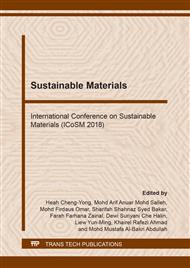p.315
p.323
p.330
p.335
p.340
p.346
p.353
p.361
p.368
Characterization of Several Microcrystalline Cellulose (MCC)-Based Agricultural Wastes via X-Ray Diffraction Method
Abstract:
In this study, microcrystalline cellulose (MCC) was extracted from various types of local agricultural wastes. Four types of agricultural waste such as coconut coir, banana stem, sugarcane bagasse and pineapple leaves were collected, extracted and hydrolyzed into microcrystalline cellulose, using pre-treatment (alkaline and bleaching) and acid hydrolysis, respectively. The extracted MCC were analyzed and compared with those of commercially available MCC. The study of crystallinity behaviors of the obtained MCC was performed by X-Ray Diffraction (XRD) analysis. The XRD of MCC revealed that the crystallinity of pineapple leaves has the highest crystallinity index with 75% in value and closest compared to commercial MCC, 81.25%. The value of crystallinity index for banana stem is 74.55% followed by coconut coir, 72.73% and sugarcane bagasse, 66.50%. All of the MCC samples showed the similar pattern with the typical crystalline structure of cellulose I. The crystallite size of all MCC samples was calculated and found in the range of 4.04 – 5.14 nm. These extracted MCC that obtained from several agricultural wastes was supposed to have a high potential as value-added products in industrial applications.
Info:
Periodical:
Pages:
340-345
Citation:
Online since:
August 2018
Price:
Сopyright:
© 2018 Trans Tech Publications Ltd. All Rights Reserved
Share:
Citation:


